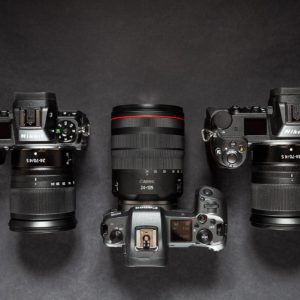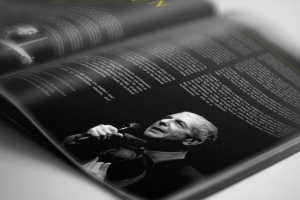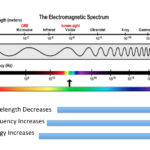Wave Dynamics
The Fundamentals
Let There Be Light!
Lesson 3: Wave Dynamics
- How Waves Make Color
- The Anatomy Of a Wave
- The Not So Scary Science
- Wavelength
- Amplitude
- Frequency
- Light vs. Sound Waves
- How Waves Move Through Space
In this lesson, you will learn the different components that make up a wave. By understanding what each part does, you’ll begin to see how changing the wave’s length, amplitude and frequency can give you a surprising amount of control over light, color and shadow.
How Waves Make Color
Now that you understand how what we perceive as light is broken into the bands of color we know as the spectrum, let’s break down the anatomy of the waves creating those color bands. We need to dissect the wave and examine its component parts so you can understand what the EM fields are doing when they create oscillation. But Gina, isn’t this an awful lot of science? No, it is not. This is a gross over-simplification of the science, designed to make this as quick as possible to avoid terrifying you. Why is all this science necessary, you ask? Because lighting is the place where most designers and even photographers absolutely fail with their images. Nothing happens in photography without light. THIS IS WHY SO MANY OF YOU CAN’T WORK COLOR CURVES OR LEVELS!!!
The one inescapable reality of photography is that you may not always be able to control lighting conditions when you’re shooting. So you have to be prepared to deal with lighting issues in post-production. Photoshop gives you lots of tools to correct lighting, but you have to know HOW to use them, and more importantly, WHEN and WHERE to use them. It’s not that hard to recognize an image that’s too dark or too washed out. But which tool do you use to correct which problem? And how do you know your changes are the right changes? Way too many of you are guessing, and guessing isn’t good enough. Your results might be good, but they could be spectacular if you understand how light works. This will help you know WHAT to do and more importantly, WHY you’re doing what you’re doing.
When you’re correcting exposure problems in your images, that’s lighting. When you’re adjusting highlights, midtones and shadows to achieve optimal levels and color curves, that’s lighting. In fact, anything having to do with luminance is literally about controlling the light in your image. But the key word here is “control”. You cannot possibly hope to control something you don’t truly understand. This will help you get a grip on your curves and histograms because you will finally, at long last, stop seeing light and color as two different things. Color is light, broken into its component parts. And if you’re going to work with color in any kind of graphic design, it would behoove you to dig into what follows, because you’re going to run into these wave dynamics everywhere, and not just with light and color. You’re going to encounter them with sound waves, animation or motion curves, and procedural textures, especially if you get into 3D animation.
The Anatomy Of A Wave
So let’s get started by understanding the Ramen noodle that is our wave. We’ll begin by breaking a wave down into its three component parts:
- WAVELENGTH: The length of the wave, as in how much space there is from peak to peak.
- AMPLITUDE: How tall the wave is, as in the height of the wave from peak to trough (top to bottom).
- FREQUENCY: How fast or slowly waves are traveling. Since the waves are in constant motion, frequency indicates how fast or slowly that wave is moving forward.
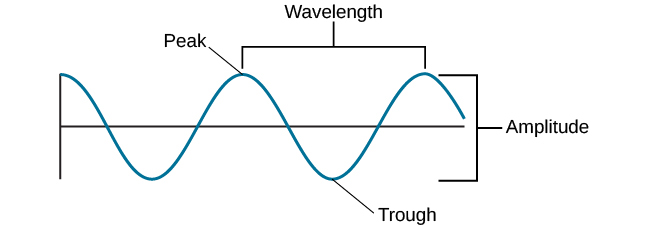
The NOt So Scary Science
So…what does all of this get you? If you understand wavelength, amplitude and frequency, you gain control over the physics of color, bumpiness or smoothness. But that’s not all. These same wave dynamics apply to sound, etc. Like I said, waves are dynamic because they act as a force on other things. Like a magnet that acts as a force that pulls on metal as it draws it towards itself on a straight line, waves have this same ability to drag light or sound in a straight line, moving in a particular direction (as in “along an axis”). That’s the M part of the “EM” field: Magnetism. For example:
Wavelength
- Wavelengths work on the X-axis (as in horizontally, left to right)
- With light waves, wavelengths affect COLOR.
- With sound waves, wavelengths affect PITCH.
Color: Changing the wavelength of light will shift the color from one end of the spectrum to the other. Longer wavelengths shift the color towards the red end of the spectrum. Shorter wavelengths shift the color towards the blue end of the spectrum.
Sound: Changing the wavelength of a sound will change the pitch from high to low. The longer the wave, the lower the pitch. The shorter the wave, the higher the pitch.
Amplitude
- Amplitude works on the Y-axis (vertically, up and down)
- With light waves, wave amplitude affects BRIGHTNESS.
- With sound waves, wave amplitude affects VOLUME.
Color: Increasing the height of a light wave increases light intensity and brightness. Decreasing the height decreases light intensity and brightness.
Sound: Increasing the height of a sound wave increases the volume. Decreasing the wave height lowers the volume.
Frequency
Frequency is inversely proportional to wavelength…say what, now? That means that increasing one decreases the other. That’s inverse proportion. You can’t change one without affecting the other.
Color: Changing the frequency of a light wave changes the color by either making the wavelength longer or shorter. Lowering the frequency pushes the color towards infrared. Increasing frequency pushes the color towards ultraviolet.
Sound: Increasing the frequency (or “Hz”) for sound waves creates more waves and increases the pitch. Decreasing frequency makes fewer waves and lowers the pitch.
The frequency with which waves are created within a fixed period of time tells you how fast or slow the waves are traveling. Altering the frequency allows you to control their speed.
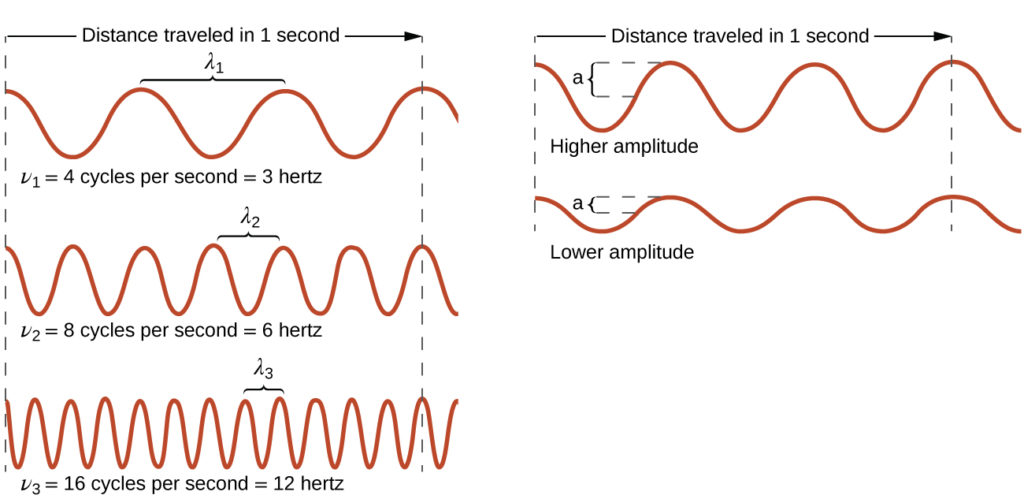
Light vs. Sound Waves
Waves are called “dynamic” because they move around and do things, as opposed to being “static”, which means “still”. The wave dynamics you are learning here will help you to understand how to use the controls, sliders and settings that come with the tools that let you adjust light, sound, even motion. They’re everywhere in graphic design software. So what you learn here will be useful in lots of places you never imagined.
Light waves and sound waves share the same anatomy. A wave is a wave. Whether they’re light waves or sound waves, they function identically. They both travel and both can be adjusted and controlled by you, the user. But there’s one important difference: Where light can travel through the vacuum of space on its own without any other means of transportation, sound cannot. Sound is “mechanical”. And by that, I mean that it requires a mechanism of some sort in order to be able to travel the infinite ocean of deep space.
Waves Can Space Travel
If you think of space as a vast ocean, light waves can travel independently, but sound waves need a boat or they can’t go anywhere. Light waves are like fish in that they can propel themselves forward on their own without needing transportation to carry them where they’re going. This is why light can travel at amazing speeds, unimpeded through space, but sound cannot. Without something like water, air or some other fluid dynamics to carry them forward, sound waves are static. They can’t move. Nothing can, not even you. That was a rather terrifying discovery the astronauts made in their early travels into space and to the moon.
Without pushing off something to beat the inertia, you can flail all you want in space, but you’re not going anywhere without a means of propelling yourself forward. But once you start moving in space, you’ll keep moving. With nothing to stop you, you’ll just float away. You can’t change direction or stop yourself because there is nothing to offer any resistance. If you swim, think of the last time you jumped off a diving board. You’re free-falling through the air until you meet the resistance of the water. The water pushes back against you, slowing your speed and breaking your fall. Without that water, you’re going to keep falling at the same velocity until you hit the bottom of the pool…a stationary object.
The Earth has been spinning for at least 4.5 billions years for exactly this reason. While it has an atmosphere, as a planetary body it exists in the vacuum of space so the same rules apply. Air matters. It may not seem very substantial as you’re breathing it, but believe me…air is a thing. Like water, atmosphere offers that same resistance to push against. Anything solid pushing against that boundary between a planet’s atmosphere and the vacuum of space will encounter friction as it rubs against it. That friction will cause the object to heat up and burn as it pierces the atmosphere.
Which makes the radiant nature of light a really powerful thing because it’s not solid, so it encounters no such resistance as it penetrates the atmosphere. If light encounters anything solid, it either bounces off of it (reflection) or it scatters itself across the object’s surface (diffusion). Being able to travel that fast through space on its own with no help is an amazing feat of physics. But the fact that it can encounter a stationary object, bounce off it, and keep on traveling through space is just genius on the part of Mother Nature.
Summary
Your new found understanding of wave dynamics means that you’re going to see Photoshop and other programs in a whole new light. Now that you understand the anatomy of light and sound waves, you’ll never look at color the same way again. In our next lesson, we’ll take a look at how the color pickers were born out of the science of light. But this wave knowledge has a downside. If you’re a Trekker or sci-fi lover who enjoys watching those great space battles where everything blows up in a huge explosion…you can go ahead and call bovine scatology on that one. It’s artistic license on the part of the writers, because it’s just not possible in the reality of physics. There’s no air in space, so sound can’t travel anywhere, no matter how loud it is. Big loud booms are a function of atmosphere, so the Big Bang was totally silent. Hollywood knows this, but if you write for TV, what are you gonna do?

